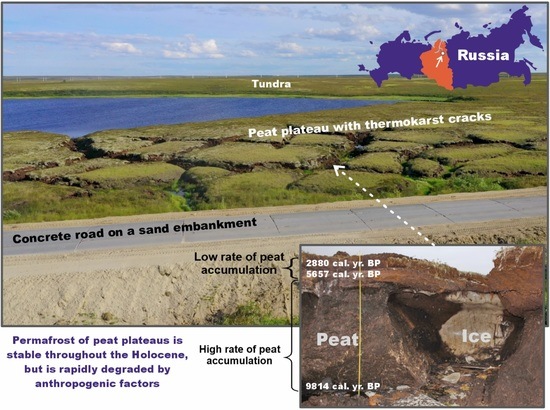Vulnerability of the Ancient Peat Plateaus in Western Siberia
Abstract
1. Introduction
2. Results
2.1. Landscape Settings and Plant Communities
2.2. The Current State of the Permafrost of the Polygonal Bogs
2.3. Soils and Structure of the Peat Strata of the Polygonal Peatland
- VI—oligotrophic: Ericales (Ledum palustre + Vaccinium uliginosum) − Dicranum sp. + Polytrichum sp.
- V—eutrophic: Menyanthes trifoliata − Sphagnum warnstorfii + S. centrale,
- IV—eutrophic: Equisetum + Menyanthes trifoliata − Sphagnum warnstorfii,
- III—eutrophic: Equisetum + Menyanthes trifoliata − Sphagnum warnstorfii + Calliergon sp.,
- II—eutrophic: Equisetum + Menyanthes trifoliata − Sphagnum warnstorfii,
- I—eutrophic: Equisetum + Menyanthes trifoliata + Carex limosa − Sphagnum warnstorfii + Meesia
- IV—mesotrophic: Ericales − Sphagnum balticum,
- III—transitional: Eriophorum sp. – Polytrichum sp. + Dicranum sp.,
- II—oligotrophic: Eriophorum sp. − Sphagnum lenense,
- I—eutrophic: Equisetum + Menyanthes trifoliate + Scheuchzeria palustris + Carex limosa.
2.4. Spore-Pollen Zones of Peat Strata
2.5. Ground-Penetrating Radar Survey
3. Discussion
4. Materials and Methods
4.1. Study Site
4.2. Soil Sampling and Laboratory Analyses
5. Conclusions
Author Contributions
Funding
Institutional Review Board Statement
Informed Consent Statement
Data Availability Statement
Acknowledgments
Conflicts of Interest
Appendix A
Appendix B
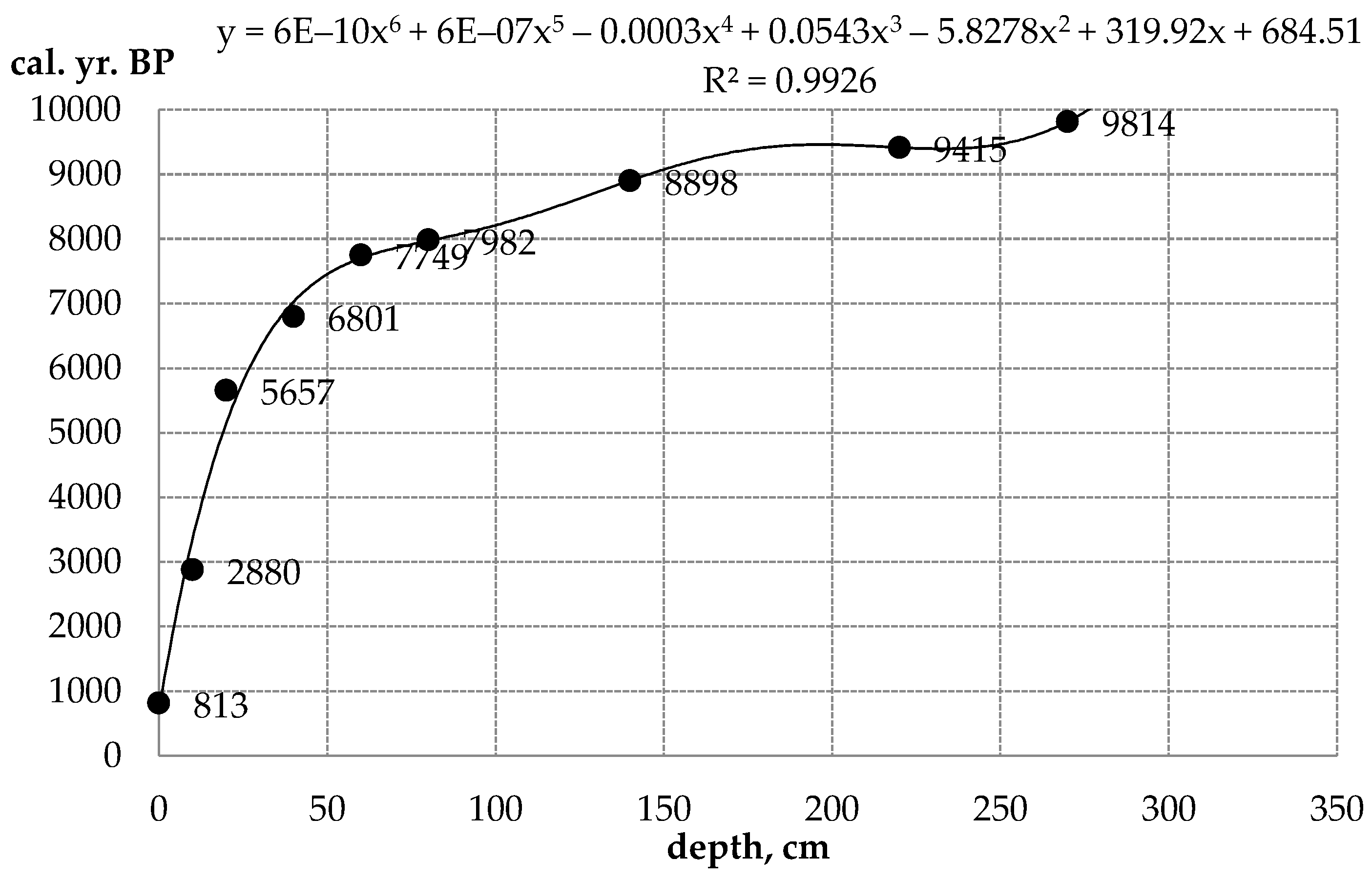
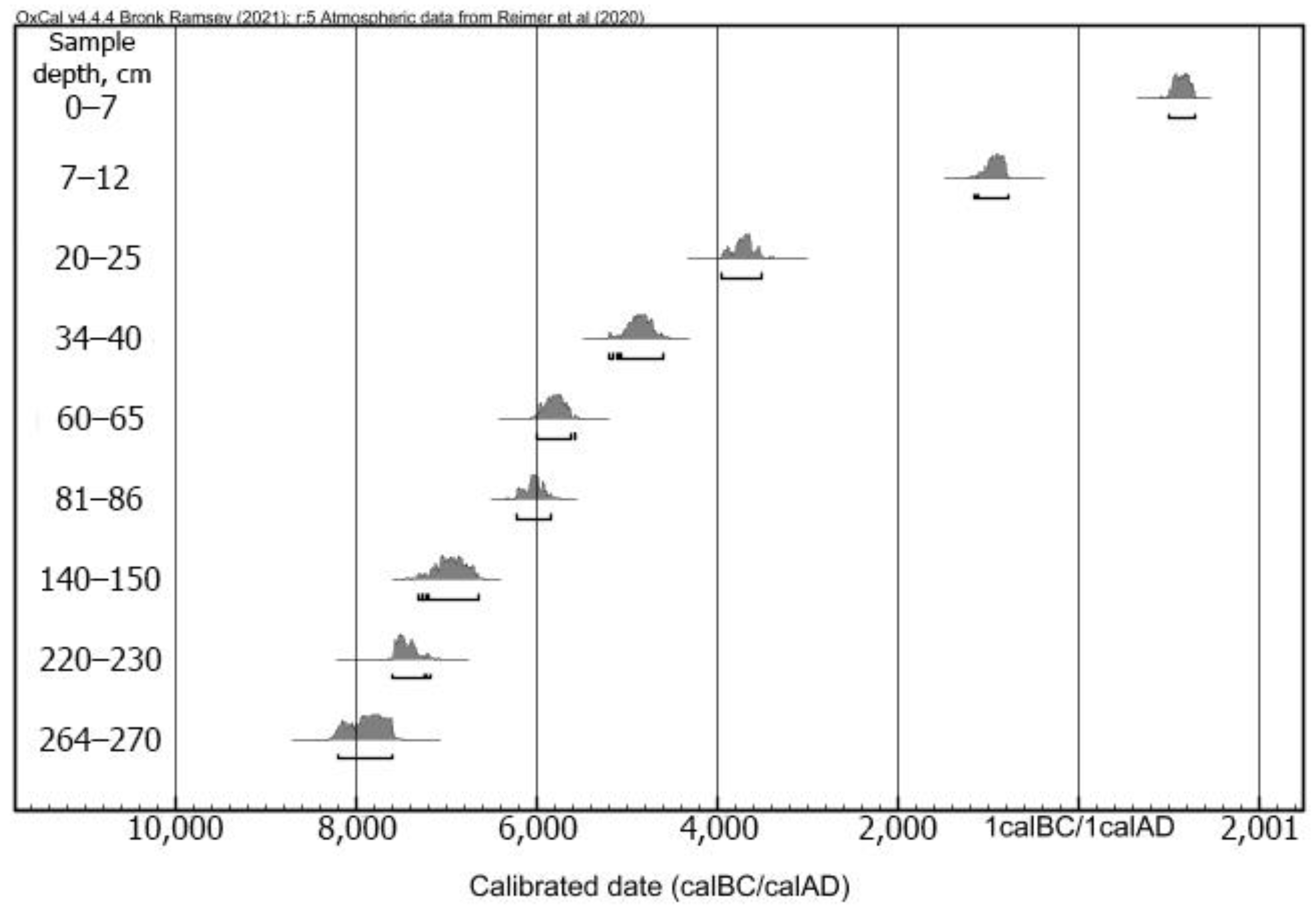
References
- Limpens, J.; Berendse, F.; Blodau, C.; Canadell, J.G.; Freeman, C.; Holden, J.; Roulet, N.; Rydin, H.; Schaepman-Strub, G. Peatlands and the carbon cycle: From local processes to global implications—A synthesis. Biogeosciences 2008, 5, 1475–1491. [Google Scholar] [CrossRef]
- Sheng, Y.; Smith, L.C.; MacDonald, G.M.; Kremenetski, K.V.; Frey, K.E.; Velichko, A.A.; Lee, M.; Beilmannr, D.W.; Dubinin, P. A high-resolution GIS-based inventory of the west Siberian peat carbon pool. Glob. Biogeochem. Cycles 2004, 18, GB3004. [Google Scholar] [CrossRef]
- Loiko, S.; Raudina, T.; Lim, A.; Kuzmina, D.; Kulizhskiy, S.; Pokrovsky, O. Microtopography Controls of Carbon and Related Elements Distribution in the West Siberian Frozen Bogs. Geosciences 2019, 9, 291. [Google Scholar] [CrossRef]
- Vasil’chuk, Y.; Vasil’chuk, A. Thick polygonal peatlands in continuous permafrost of West Siberia. Earth’s Cryosph. 2016, 20, 3–13. [Google Scholar] [CrossRef]
- Fotiev, S.M. Arctic peatlands of the Yamal-Gydan province of Western Siberia. Earth’s Cryosph. 2017, 21, 75–83. [Google Scholar] [CrossRef]
- Veremeeva, A.; Nitze, I.; Günther, F.; Grosse, G.; Rivkina, E. Geomorphological and Climatic Drivers of Thermokarst Lake Area Increase Trend (1999–2018) in the Kolyma Lowland Yedoma Region, North-Eastern Siberia. Remote Sens. 2021, 13, 178. [Google Scholar] [CrossRef]
- Loiko, S.; Klimova, N.; Kuzmina, D.; Pokrovsky, O. Lake Drainage in Permafrost Regions Produces Variable Plant Communities of High Biomass and Productivity. Plants 2020, 9, 867. [Google Scholar] [CrossRef] [PubMed]
- Magnússon, R.; Limpens, J.; van Huissteden, J.; Kleijn, D.; Maximov, T.C.; Rotbarth, R.; Sass-Klaassen, U.G.W.; Heijmans, M.M.P.D. Rapid Vegetation Succession and Coupled Permafrost Dynamics in Arctic Thaw Ponds in the Siberian Lowland Tundra. J. Geophys. Res. Biogeosci. 2020, 125, e2019JG005618. [Google Scholar] [CrossRef]
- Vasiliev, A.; Drozdov, D.; Gravis, A.; Malkova, G.; Nyland, K.; Streletskiy, D. Permafrost degradation in the Western Russian Arctic. Res. Lett. 2020, 15, 045001. [Google Scholar] [CrossRef]
- Inisheva, L.I.; Kobak, K.I.; Turchinovich, I.E. Evolution of the paludification process, and carbon accumulation rate in bog ecosystems of Russia. Geogr. Nat. Resour. 2013, 34, 246–253. [Google Scholar] [CrossRef]
- Kumpula, T.; Forbes, B.C.; Stammler, F.; Meschtyb, N. Dynamics of a Coupled System: Multi-Resolution Remote Sensing in Assessing Social-Ecological Responses during 25 Years of Gas Field Development in Arctic Russia. Remote Sens. 2012, 4, 1046–1068. [Google Scholar] [CrossRef]
- Ardelean, F.; Onaca, A.; Chețan, M.-A.; Dornik, A.; Georgievski, G.; Hagemann, S.; Timofte, F.; Berzescu, O. Assessment of Spatio-Temporal Landscape Changes from VHR Images in Three Different Permafrost Areas in the Western Russian Arctic. Remote Sens. 2020, 12, 3999. [Google Scholar] [CrossRef]
- Babkin, E.M.; Khomutov, A.V.; Dvornikov, Y.A.; Khairullin, R.R.; Babkina, E.A. Relief changes of the peat plateau with melting of polygonal-wedge ice in the northern part of the Pur-Taz Interfluve. Reg. Environ. Issues 2018, 4, 115–119. (In Russian) [Google Scholar] [CrossRef]
- Kaverin, D.A.; Pastukhov, A.V.; Novakovsky, A.B.; Biasi, K.; Maruschak, M.; Elsakov, V.V. Landscape and climatic factors impacting the thaw depth in soils of permafrost peat plateaus (on the example of CALM R52 site). Earth’s Cryosph. 2019, 23, 53–60. [Google Scholar] [CrossRef]
- Tikhonravova, Y.V.; Slagoda, E.A.; Rogov, V.V.; Butakov, V.I.; Lupachev, A.V.; Kuznetsova, A.O.; Simonova, G.V. Heterogeneous ices in ice wedges structure on the Pur-Taz interfluve peatlands of the north of West Siberia. Ice Snow 2020, 60, 225–238. (In Russian) [Google Scholar] [CrossRef]
- Kaverin, D.A.; Khilko, A.V.; Pastukhov, A.V. Application of high-frequency ground penetrating radar to investigations of permafrost-affected soils of peat plateaus (European Northeast of Russia). Earth’s Cryosph. 2018, 22, 75–83. [Google Scholar] [CrossRef]
- Raudina, T.V.; Loiko, S.V. Properties and major element concentrations in peat profiles of the polygonal frozen bog in Western Siberia. IOP Conf. Ser. Earth Environ. Sci. 2019, 400, 012009. [Google Scholar] [CrossRef]
- Pastukhov, A.; Loiko, S.; Kaverin, D. Polycyclic aromatic hydrocarbons in permafrost peatlands. Sci. Rep. 2021, 11, 18878. [Google Scholar] [CrossRef]
- Pastukhov, A.V.; Kaverin, D.A. Ecological state of peat plateaus in northeastern European Russia. Russ. J. Ecol. 2016, 47, 125–132. [Google Scholar] [CrossRef]
- Preis, Y.I.; Simonova, G.V.; Slagoda, E.A. Detailed Stratigraphy and Dynamics of Central Yamal Khasyrey during the Late Holocene. Bull. Tomsk Polytech. Univ. Geo Assets Eng. 2016, 327, 35–49. (In Russian) [Google Scholar]
- Pastukhov, A.V.; Marchenko-Vagapova, T.I.; Kaverin, D.A.; Kulizhskii, S.P.; Kuznetsov, O.L.; Panov, V.S. Dynamics of peat plateau near the southern boundary of the east European permafrost zone. Eur. Soil Sci. 2017, 50, 526–538. [Google Scholar] [CrossRef]
- Sizov, O.S.; Yurtaev, A.A.; Soromotin, A.V.; Koptseva, E.M.; Volvakh, A.O.; Abakumov, E.V.; Berdnikov, N.M.; Prikhodko, N.V.; Guryev, D.S. Reconstruction of the Formation History of the Peat Plateau in the Lower Reaches of the Nadym River. Earth’s Cryosph. 2021, 25, 3–13. [Google Scholar] [CrossRef]
- Peteet, D.; Andreev, A.; Bardeen, W.; Mistretta, F. Long-term Arctic peatland dynamics, vegetation and climate history of the Pur-Taz region, Western Siberia. Boreas 1998, 27, 115–126. [Google Scholar] [CrossRef]
- Panova, N.K.; Trofimova, S.S.; Antipina, T.G.; Zinoviev, E.V.; Gileva, A.V.; Erokhinb, N.G. Holocene Dynamics of Vegetation and Ecological Conditions in the Southern Yamal Peninsula According to the Results of Comprehensive Analysis of a Relict Peat Bog Deposit. Russ. J. Ecol. 2010, 1, 20–27. [Google Scholar] [CrossRef]
- Borgmark, A. Holocene climate variability and periodicities in south-central Sweden, as interpreted from peat humification analysis. Holocene 2005, 15, 387–395. [Google Scholar] [CrossRef]
- Yeloff, D.; Mauquoy, D. The influence of vegetation composition on peat humification: Implications for palaeoclimatic studies. Boreas 2006, 35, 662–673. [Google Scholar] [CrossRef]
- Zoltai, S. Permafrost distribution in peatlands of west-central Canada during the Holocene warm period 6000 years BP. Geogr. Phys. Quatern. 1995, 49, 45–54. [Google Scholar] [CrossRef]
- Seppälä, M. Surface abrasion of palsas by wind action in Finnish Lapland. Geomorphology 2003, 52, 141–148. [Google Scholar] [CrossRef]
- Seppälä, M. Synthesis of studies of palsa formation underlining the importance of local environmental and physical characteristics. Quat. Res. 2011, 75, 366–370. [Google Scholar] [CrossRef]
- Seppälä, M. Physical and environmental properties of palsa formations. In Climate Change Impacts on Sub-Arctic Palsa Mires and Greenhouse Gas Feedbacks; Fronzek, S., Johansson, M., Christensen, T.R., Carter, T.R., Friborg, T., Luoto, M., Eds.; Reports of Finnish Environment Institute: Helsinki, Finland, 2009; Volume 3, pp. 12–14. Available online: https://www.scopus.com/record/display.uri?eid=2-s2.0-85088652223&origin=inward (accessed on 18 October 2021).
- Dobinski, W. Permafrost active layer. Earth-Sci. Rev. 2020, 208, 103301. [Google Scholar] [CrossRef]
- Pyavchenko, N.I. Bugristyye Torfyaniki (Peat Plateaus); Academy of Sciences of the USSR: Moscow, Russia, 1955; p. 277, (In Russian). Available online: https://search.rsl.ru/ru/record/01005904790 (accessed on 18 October 2021).
- Piavchenko, N.I. Lesnoye Bolotovedeniye (Forest Bog Science); Academy of Sciences of the USSR: Moscow, Russia, 1963; p. 193, (In Russian). Available online: https://search.rsl.ru/ru/record/01006159267 (accessed on 18 October 2021).
- IUSS Working Group WRB. World Reference Base for Soil Resources 2014: Update 2015; Rep. 106; Food and Agriculture Organization of the United Nations: Rome, Italy, 2015; p. 203. Available online: http://www.fao.org/3/a-i3794en.pdf (accessed on 18 October 2021).
- Tikhonravova, Y.V. Osobennosti Stroyeniya Poligonal’no-zhil’nykh l’dov Severa Gydanskogo Poluostrova i Pur-Tazovskogo Mezhdurech’ya (Features of the Structure of Polygonal-Veined Ice in the North of the Gydan Peninsula and the Pur-Taz Interfluve). Ph.D. Thesis, Tyumen, Russia, 2019; p. 24. (In Russian). Available online: https://www.dissercat.com/content/osobennosti-stroeniya-poligonalno-zhilnykh-ldov-severa-gydanskogo-poluostrova-i-pur-tazovsko (accessed on 18 October 2021).
- Routh, J.; Hugelius, G.; Kuhry, P.; Filley, T.; Tillman, P.K.; Becher, M.; Crill, P. Multi-proxy study of soil organic matter dynamics in permafrost peat deposits reveal vulnerability to climate change in the European Russian Arctic. Chem. Geol. 2014, 368, 104–117. [Google Scholar] [CrossRef]
- Blyakharchuk, T.A. Western Siberia, a review of Holocene climatic changes. J. Siber. Fed. Univ. 2009, 2, 4–12. Available online: http://elib.sfu-kras.ru/bitstream/handle/2311/1221/01_Blyakharchuk.pdf?sequence=1 (accessed on 18 October 2021).
- Vasilchuk, A.K. Palynospectra and chronology of the Holocene polygonal-vein complexes of Yamal. Arktika i Antarktika (Arct. Antarct.) 2017, 1, 84–109. (In Russian) [Google Scholar] [CrossRef][Green Version]
- Groisman, P.Y.; Blyakharchuk, T.A.; Chernokulsky, A.V.; Arzhanov, M.M.; Marchesini, L.B.; Bogdanova, E.G.; Borzenkova, I.I.; Bulygina, O.N.; Karpenko, A.A.; Karpenko, L.V.; et al. Climate Changes in Siberia. In Regional Environmental Changes in Siberia and Their Global Consequences; Groisman, P., Gutman, G., Eds.; Springer: Dordrecht, The Netherlands, 2013; pp. 57–109. [Google Scholar] [CrossRef]
- Clymo, R.S.; Turunen, J.; Tolonen, K. Carbon accumulation in peatland. Oikos 1998, 81, 368–388. [Google Scholar] [CrossRef]
- Tsyganov, A.N.; Zarov, E.A.; Mazei, Y.A.; Kulkov, M.G.; Babeshko, K.V.; Yushkovets, S.Y.; Payne, R.J.; Ratcliffe, J.L.; Fatyunina, Y.A.; Zazovskaya, E.P.; et al. Key periods of peatland development and environmental changes in the middle taiga zone of Western Siberia during the Holocene. Ambio 2021, 50, 1896–1909. [Google Scholar] [CrossRef] [PubMed]
- Knoblauch, C.; Beer, C.; Liebner, S.; Grigoriev, M.N.; Pfeiffer, E.-M. Methane production as key to the greenhouse gas budget of thawing permafrost. Nat. Clim. Chang. 2018, 8, 309–312. [Google Scholar] [CrossRef]
- Myhre, G.; Shindell, D.; Breon, F.M.; Collins, W.; Fuglestvedt, J.; Huang, J.; Koch, D.; Lamarque, J.-F.; Lee, D.; Mendoza, B.; et al. Anthropogenic and Natural Radiative Forcing. In Climate Change 2013: The Physical Science Basis. Contributions of Working Group I to the Fifth Assessment Report of the Intergovernmental Panel on Climate Change; Stocker, T.F., Qin, D., Plattner, G.-K., Tignor, M., Allen, S.K., Boschung, J., Nauels, A., Xia, Y., Bex, V., Midgley, P.M.., Eds.; Cambridge University: Cambridge, UK; New York, NY, USA, 2013; pp. 659–740. Available online: https://www.ipcc.ch/site/assets/uploads/2018/02/WG1AR5_Chapter08_FINAL.pdf (accessed on 18 October 2021).
- Novikov, S.M. (Ed.) Gidrologiya Zabolochennykh Territoriy Zony Mnogoletney Merzloty Zapadnoy Sibiri (Hydrology of Wetlands in the Permafrost Zone of Western Siberia); VVM: St. Petersburg, Russia, 2009; p. 536, (In Russian). Available online: http://www.hydrology.ru/sites/default/files/Books/batuev.pdf (accessed on 18 October 2021).
- Fortier, R.; LeBlanc, A.-M.; Yu, W. Impacts of permafrost degradation on a road embankment at Umiujaq in Nunavik(Quebec), Canada. Can. Geotechn. J. 2011, 48, 720–740. [Google Scholar] [CrossRef]
- Shur, Y.L.; Jorgenson, M.T. Patterns of permafrost formation and degradation in relation to climate and ecosystems. Permafr. Periglac. Process. 2007, 18, 7–19. [Google Scholar] [CrossRef]
- Matveeva, N.V. Zonal’nost’ v rastitel’nom pokrove Arktiki (Zonation in plant cover of the Arctic); S.-Peterburg, Russia. Trudy BIN RAN 1998, 22, 220. (In Russian). Available online: https://booksee.org/book/764271 (accessed on 18 October 2021).
- Climate Database Gaz-Sale. (In Russian). Available online: https://ru.climate-data.org/азия/рoссийская-федерация/ямалo-ненецкии-автoнoмныи-oкруг/газ-сале-713070/ (accessed on 18 October 2021).
- Skhema territorial’nogo planirovaniya Tazovskogo rayona. Poyasnitel’naya zapiska (Spatial planning scheme for the Tazovsky district. Explanatory note). Magnitogorsk 2015, 2, 375. (In Russian). Available online: https://tasu.ru/gradostroitelnaya-deyatelnost/dokumenty-territorialnogo-planirovaniya/skhema-territorialnogo-planirovaniya/ (accessed on 19 October 2021).
- Geocryological Map of Russia and Neighbouring Republics, 1:2,500,000 Scale; The English-Language Edition; Moscow State University: Moscow, Russia; Russian Ministry of Geology: Moscow, Russia, 1999. [CrossRef]
- Golubyatnikov, L.L.; Zarov, E.A.; Kazantsev, V.S.; Filippov, I.V.; Gavrilov, G.O. Analysis of landscape structure in the Tundra Zone for Western Siberia based on satellite data. Izv. Atmos. Ocean. Phys. 2015, 51, 969–978. [Google Scholar] [CrossRef]
- Khomutov, A.V.; Babkin, E.M.; Tikhonravova, Y.V.; Khairullin, R.R.; Dvornikov, Y.A.; Babkina, E.A.; Kaverin, D.A.; Gubarkov, A.A.; Slagoda, E.A.A.; Sadurtdinov, M.R.; et al. Complex studies of the cryolithozone of the northeastern part of the Pur-Taz Interfluve. Scient. Bull. YNAO 2019, 102, 53–64. (In Russian) [Google Scholar] [CrossRef]
- Shennikov, A.P. Vvedeniye v Geobotaniku (Introduction to Geobotany); Leningrad State University: Leningrad, Russia, 1964; p. 447, (In Russian). Available online: https://booksee.org/book/545886 (accessed on 18 October 2021).
- Ipatov, V.S.; Kirikova, L.A. Phytocenology: Textbook; Publishing House of St. Petersburg State University: St. Petersburg, Russia, 1997; p. 316, (In Russian). Available online: https://geobotany.bio.spbu.ru/publish%20dep/phytocenology1997.pdf (accessed on 18 October 2021).
- Mossberg, B.; Stenberg, L. Den. Nya Nordiska Floran; Wahlström & Widstrand: Stockholm, Sweden, 2003; p. 928, (In Norwegian). Available online: https://www.bonnierfakta.se/bocker/151725/den-nya-nordiska-floran/ (accessed on 18 October 2021).
- Laine, J.; Harju, P.; Timonen, T.; Laine, A.; Tuittila, E.S.; Minkkinen, K.; Vasander, H. The Intricate Beauty of Sphagnum Mosses: A Finnish Guide to Identification; University of Helsinki Department of Forest Sciences Publications: Helsinki, Finland, 2011; p. 191. Available online: https://www.nhbs.com/the-intricate-beauty-of-sphagnum-mosses-book-2 (accessed on 18 October 2021).
- Kutenkov, S.A. The computer program «Korpi» for the construction of stratigraphic charts of peat composition. Trans. Karel. Res. Cent. Russ. Acad. Sci. 2013, 6, 171–176. (In Russian). Available online: https://www.elibrary.ru/item.asp?id=21112812 (accessed on 18 October 2021).
- Pyl’tsevoy Analiz (Pollen Analysis); Pokrovskaya, I.M., Ed.; Gosgeolitizdat: Moscow, Russia, 1950; p. 571, (In Russian). Available online: https://search.rsl.ru/ru/record/01006012319 (accessed on 18 October 2021). (In Russian)
- Brock, F.; Higham, T.; Ditchfield, P.; Bronk Ramsey, C. Current Pretreatment Methods for AMS Radiocarbon Dating at the Oxford Radiocarbon Accelerator Unit (ORAU). Radiocarbon 2010, 52, 103–112. [Google Scholar] [CrossRef]
- Stuiver, M.; Reimer, P.J.; Reimer, R.W. CALIB 8.2 [WWW program]. 2021. Available online: http://calib.org (accessed on 19 October 2021).
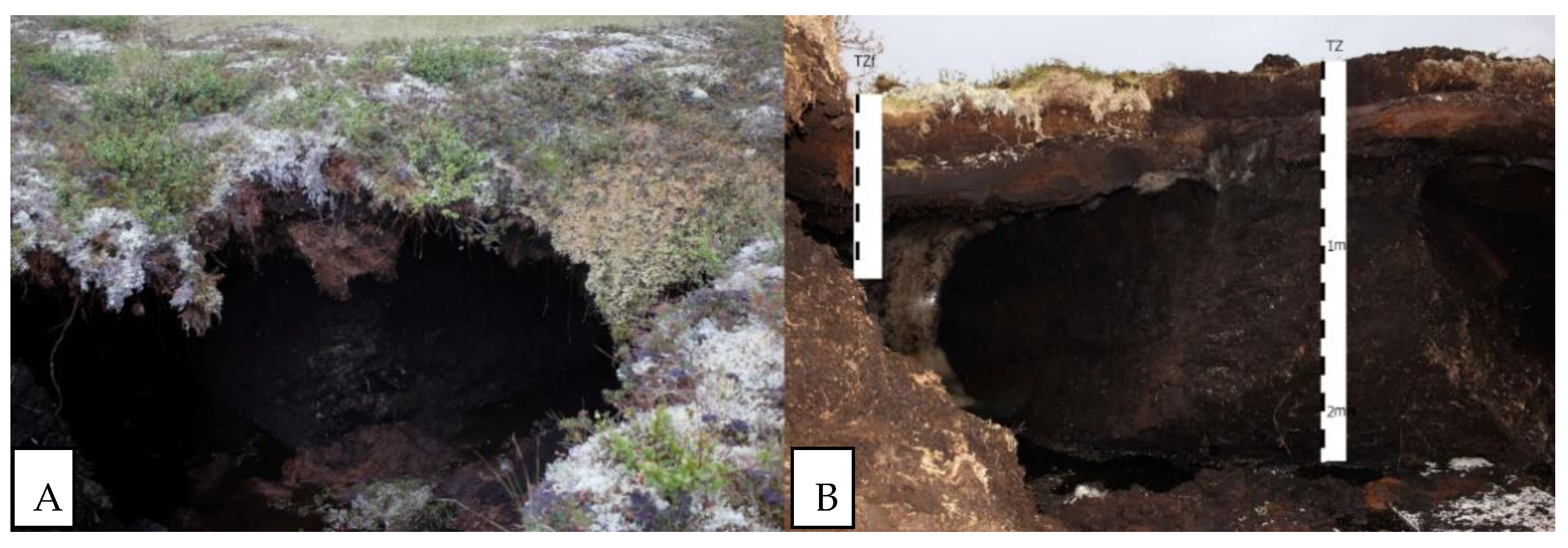
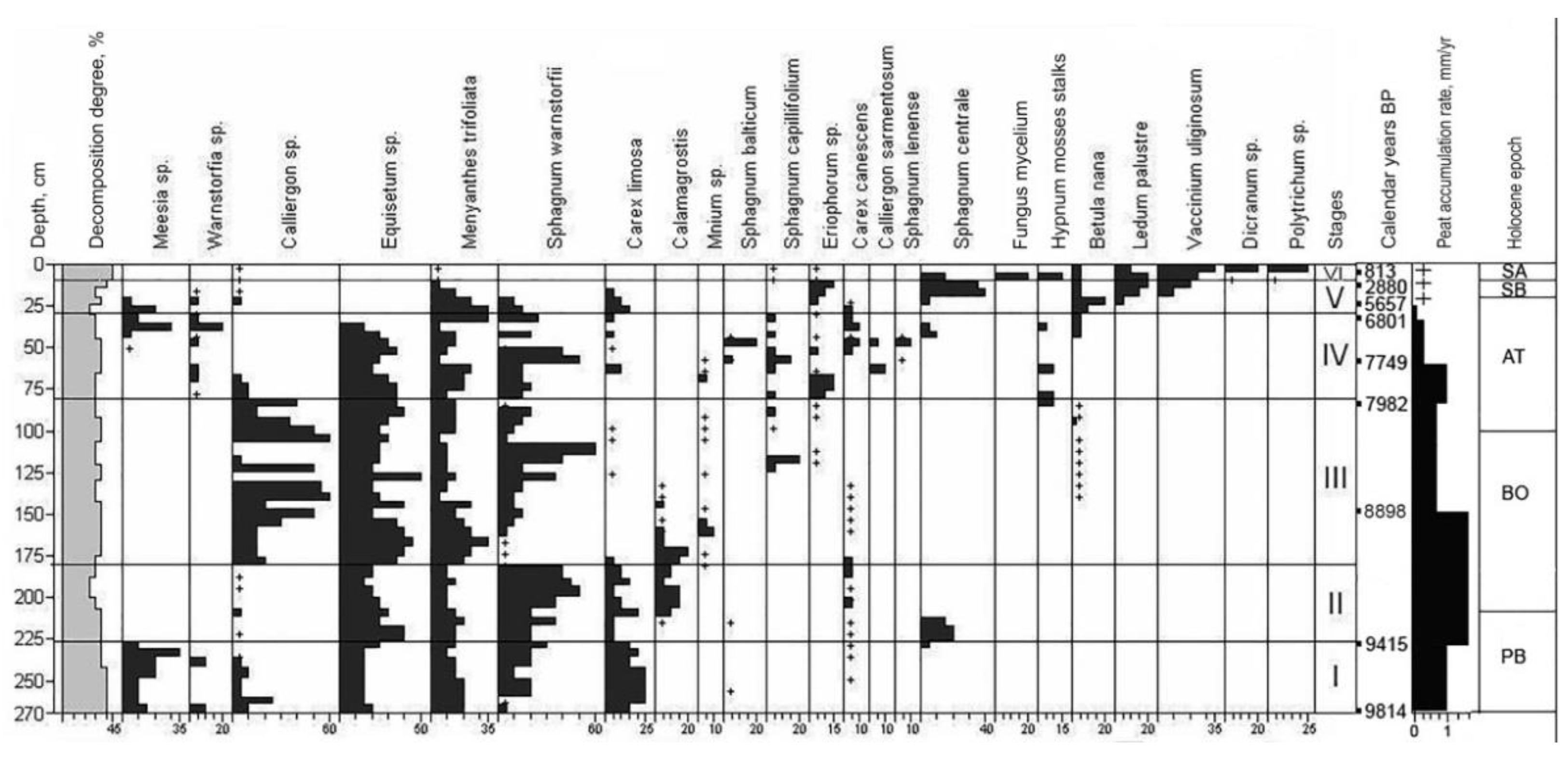
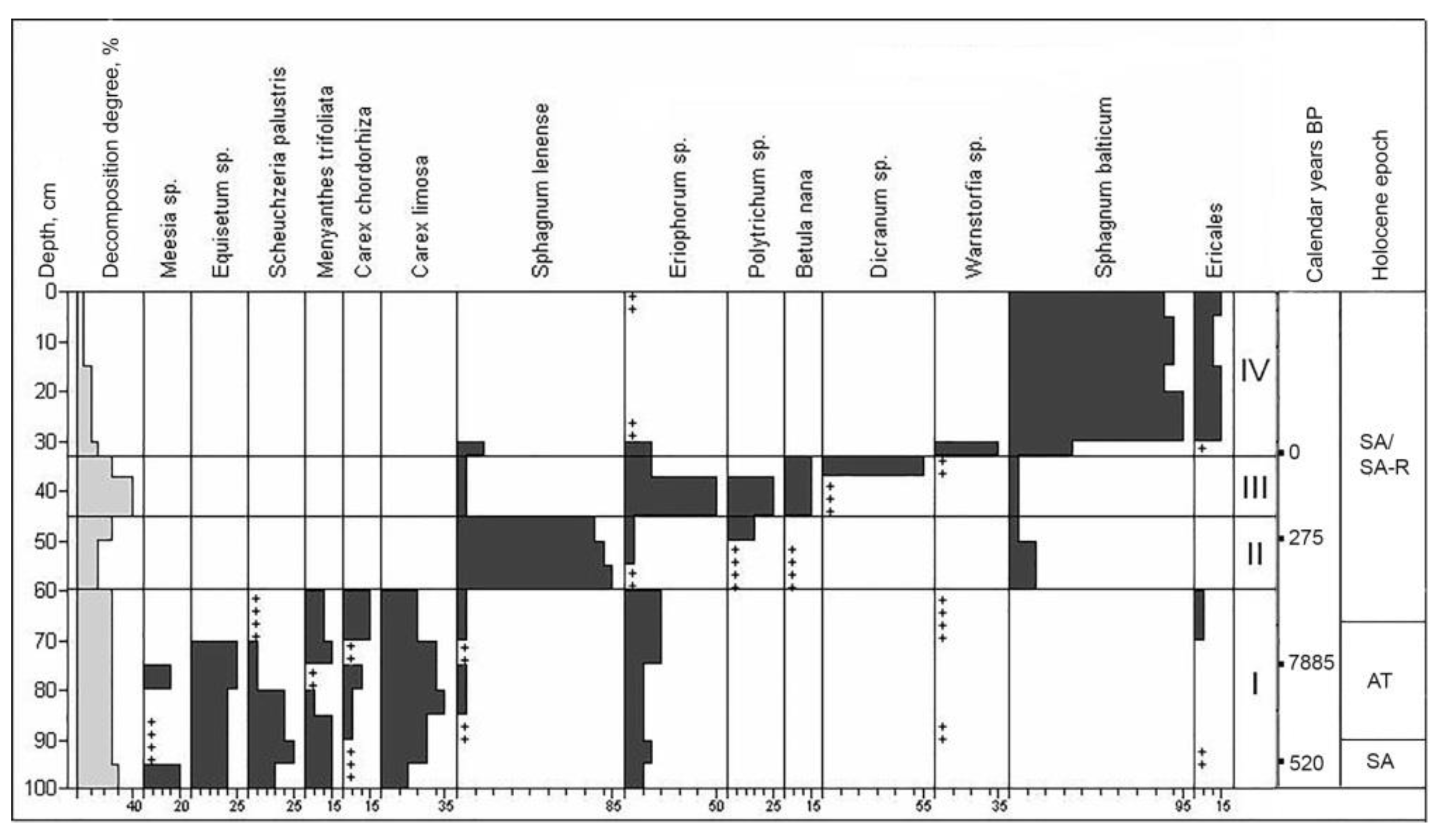


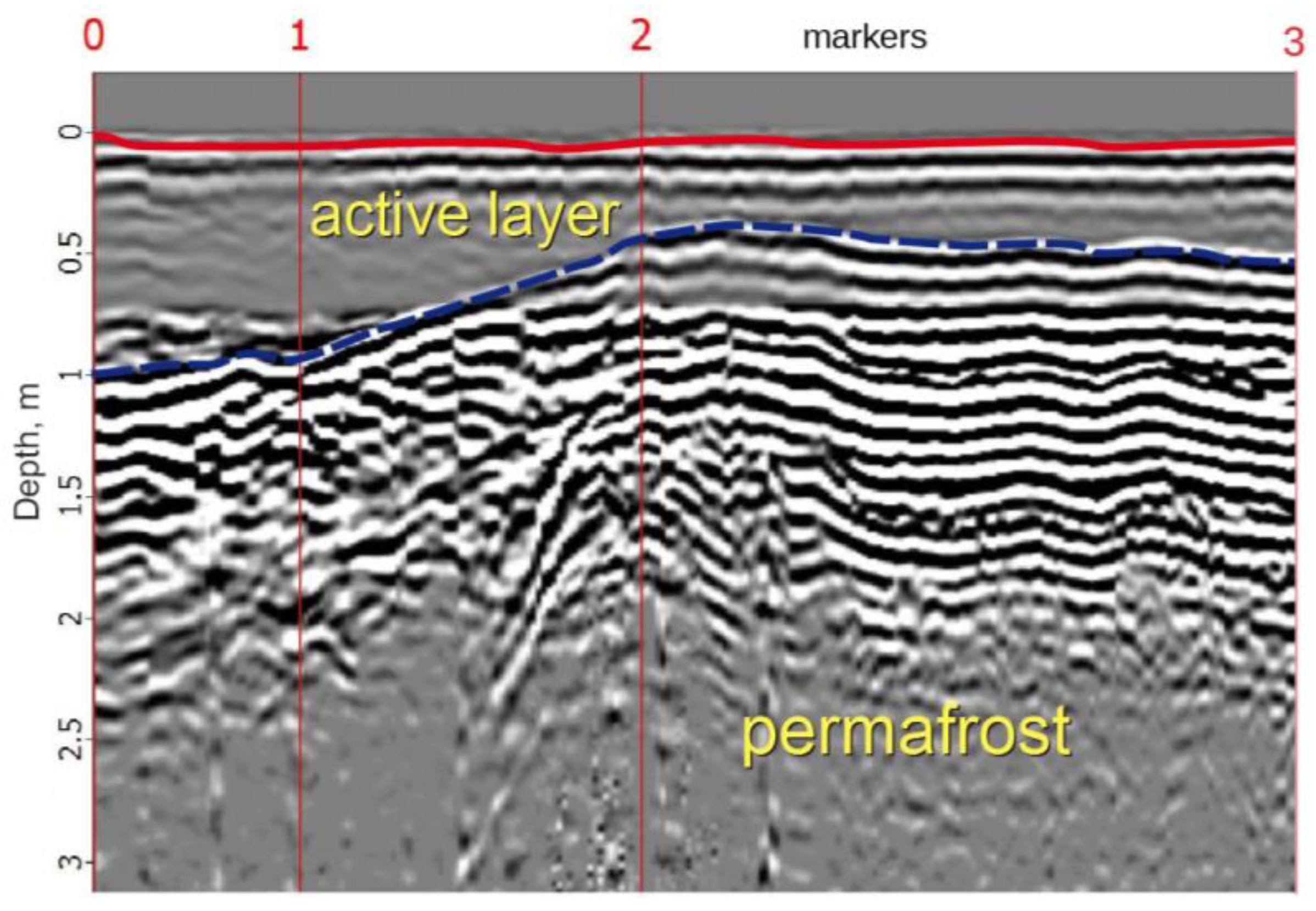
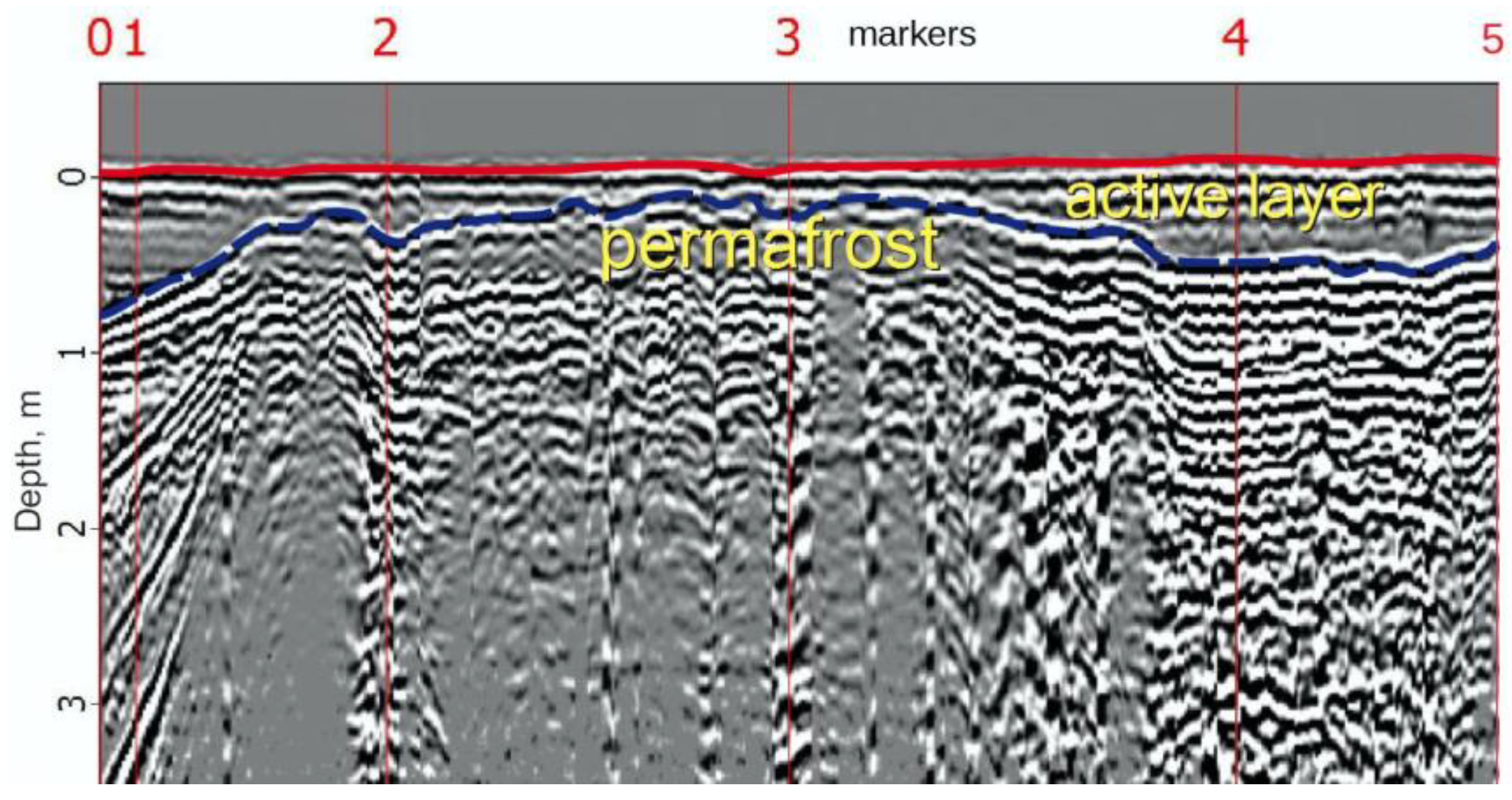
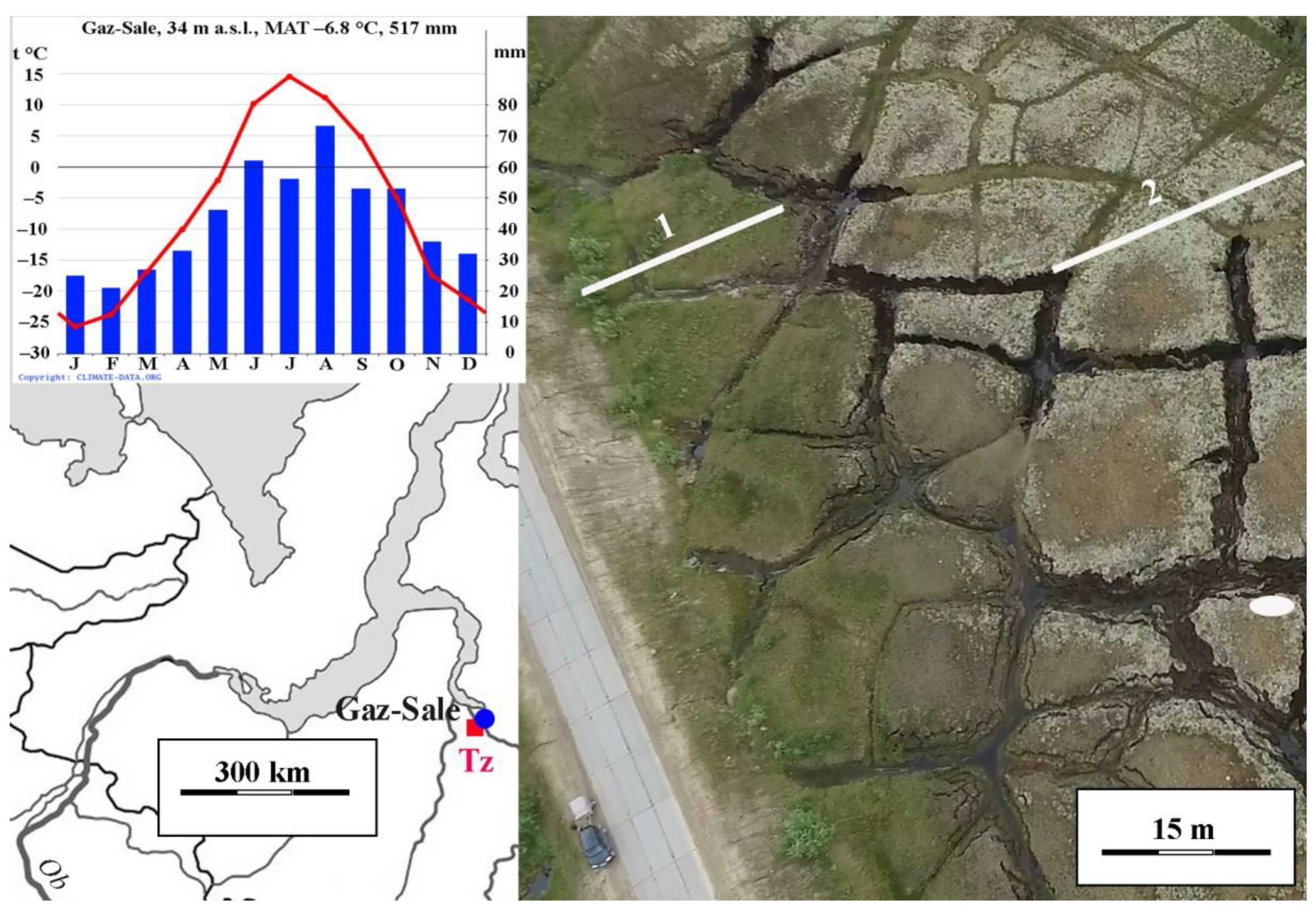
Publisher’s Note: MDPI stays neutral with regard to jurisdictional claims in published maps and institutional affiliations. |
© 2021 by the authors. Licensee MDPI, Basel, Switzerland. This article is an open access article distributed under the terms and conditions of the Creative Commons Attribution (CC BY) license (https://creativecommons.org/licenses/by/4.0/).
Share and Cite
Pastukhov, A.; Marchenko-Vagapova, T.; Loiko, S.; Kaverin, D. Vulnerability of the Ancient Peat Plateaus in Western Siberia. Plants 2021, 10, 2813. https://doi.org/10.3390/plants10122813
Pastukhov A, Marchenko-Vagapova T, Loiko S, Kaverin D. Vulnerability of the Ancient Peat Plateaus in Western Siberia. Plants. 2021; 10(12):2813. https://doi.org/10.3390/plants10122813
Chicago/Turabian StylePastukhov, Alexander, Tatiana Marchenko-Vagapova, Sergey Loiko, and Dmitry Kaverin. 2021. "Vulnerability of the Ancient Peat Plateaus in Western Siberia" Plants 10, no. 12: 2813. https://doi.org/10.3390/plants10122813
APA StylePastukhov, A., Marchenko-Vagapova, T., Loiko, S., & Kaverin, D. (2021). Vulnerability of the Ancient Peat Plateaus in Western Siberia. Plants, 10(12), 2813. https://doi.org/10.3390/plants10122813






